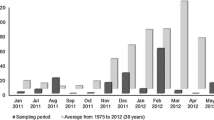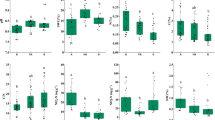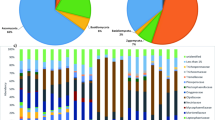Abstract
Microbes play an essential role in agricultural ecosystems; however, the processes that drive the microbial biogeographic and co-occurrence patterns have rarely been assessed simultaneously, especially in the broomcorn millet rhizosphere. In this work, we explored the spatial distribution and association networks of bacteria and fungi in the rhizosphere of broomcorn millet selected from 12 locations across northern China using high-throughput sequencing. We decomposed the β-diversity into species turnover and nestedness, confirming that the bacterial and fungal β-diversity in the broomcorn millet rhizosphere was almost entirely linked to species turnover. Distance-decay relationships revealed that the biogeographic patterns of rhizosphere bacterial and fungal β-diversity (including species turnover rather than nestedness) were clearly distinct. Environmental selection was the only factor determining the rhizosphere bacterial β-diversity, whereas the rhizosphere fungal β-diversity was governed by both environmental selection and dispersal limitation. We also demonstrated that mean annual temperature (MAT) and pH were the major ecological drivers regulating the bacterial and fungal community structure, keystone species, and modularisation in the broomcorn millet rhizosphere. This elucidated different mechanisms of bacterial and fungal biogeographic and co-occurrence patterns in the broomcorn millet rhizosphere, and provided new ideas and basic insights for an in-depth understanding of the biogeography and coexistence theory of broomcorn millet rhizosphere ecosystems.






Similar content being viewed by others
References
Barberan A, Bates ST, Casamayor EO, Fierer N (2012) Using network analysis to explore co-occurrence patterns in soil microbial communities. ISME J 6:343–351
Baselga A (2010) Partitioning the turnover and nestedness components of beta diversity. Glob Ecol Biogeogr 19:134–143
Baselga A, Orme CDL (2012) Betapart: an r package for the study of beta diversity. Methods Ecol Evol 3:808–812
Brown J, Gillooly J, Allen A, Savage V, West G, Allan A, Brown JH, Gillooly JE, Savage VM, West GB (2004) Towards a metabolic theory of ecology. Ecology 85:1771–1789
Cao XN, Wang JJ, Liu SC, Chen LB, Qiao ZJ (2020) Effect of different fertilizers on the bacterial community diversity in rhizosperic soil of broomcorn millet (Panicum miliaceum L.). Archives of Agronomy and Soil Science
Chen W, Jiao S, Li Q, Du N (2020) Dispersal limitation relative to environmental filtering governs the vertical small-scale assembly of soil microbiomes during restoration. J Appl Ecol 57:402–412
Cheng W (2009) Rhizosphere priming effect: its functional relationships with microbial turnover, evapotranspiration, and c–n budgets. Soil Biol Biochem 41:1795–1801
Chesson P (2000) Mechanisms of maintenance of species diversity. Annu Rev Ecol Syst 31:343–366
Delgado-Baquerizo M, Oliverio AM, Brewer TE, Benavent-Gonzalez A, Eldridge DJ, Bardgett RD, Maestre FT, Singh BK, Fierer N (2018) A global atlas of the dominant bacteria found in soil. Science 359:320–325
Dennis PG, Miller AJ, Hirsch PR (2010) Are root exudates more important than other sources of rhizodeposits in structuring rhizosphere bacterial communities? FEMS Microbiol Ecol 72:313–327
Du SC, Dini-Andreote F, Zhang N, Liang CL, Yao ZY, Zhang HJ, Zhang DM, Cann I (2020) Divergent co-occurrence patterns and assembly processes structure the abundant and rare bacterial communities in a salt marsh ecosystem. Appl Environ Microbiol 86:e320–e322
Edgar RC, Haas BJ, Clemente JC, Quince C, Knight R (2011) Uchime improves sensitivity and speed of chimera detection. Bioinformatics 27:2194–2200
Fan K, Cardona C, Li Y, Shi Y, Xiang X, Shen C, Wang H, Gilbert JA, Chu H (2017) Rhizosphere-associated bacterial network structure and spatial distribution differ significantly from bulk soil in wheat crop fields. Soil Biol Biochem 113:275–284
Fan K, Weisenhorn P, Gilbert JA, Chu H (2018a) Wheat rhizosphere harbors a less complex and more stable microbial co-occurrence pattern than bulk soil. Soil Biol Biochem 125:251–260
Fan K, Weisenhorn P, Gilbert JA, Shi Y, Bai Y, Chu H (2018b) Soil ph correlates with the co-occurrence and assemblage process of diazotrophic communities in rhizosphere and bulk soils of wheat fields. Soil Biol Biochem 121:185–192
Fan M, Li J, Yan W, Shi H, Shangguan Z (2021) Shifts in the structure and function of wheat root-associated bacterial communities in response to long-term nitrogen addition in an agricultural ecosystem. Applied Soil Ecology 159:103852
Faust K, Raes J (2012) Microbial interactions: from networks to models. Nat Rev Microbiol 10:538–550
Fierer N, Jackson RB (2006) The diversity and biogeography of soil bacterial communities. Proc Natl Acad Sci USA 103:626–631
Green J, Bohannan B (2006) Spatial scaling of microbial biodiversity. Trends Ecol Evol 21:501–507
Guan Y, Jiang N, Wu Y, Yang Z, Bello A, Yang W (2021) Disentangling the role of salinity-sodicity in shaping soil microbiome along a natural saline-sodic gradient. Science of the Total Environment 765:142738
Han JDJ, Bertin N, Hao T, Goldberg DS, Berriz GF, Zhang LV, Dupuy D (2004) Evidence for dynamically organized modularity in the yeast protein-protein interaction network. Nature 430:88–93
Hanson CA, Fuhrman JA, Horner-Devine MC, Martiny J (2012) Beyond biogeographic patterns: processes shaping the microbial landscape. Nat Rev Microbiol 10:497–506
Harrell FJ, Dupont C (2017) Hmisc: harrell miscellaneous. R package version 4.0–3 online publication
Hou J, Wu, L, Liu W, Ge Y, Mu T, Zhou T, Li Z, Zhou J, Sun X, Luo Y, Christie P (2020) Biogeography and diversity patterns of abundant and rare bacterial communities in rice paddy soils across china. Science of the Total Environment 730:139116
Jiang YJ, Liang YT, Li CM, Wang F, Sui YY (2016) Crop rotations alter bacterial and fungal diversity in paddy soils across east asia. Soil Biol Biochem 95:250–261
Jiao S, Xu Y, Zhang J, Lu Y (2019) Environmental filtering drives distinct continental atlases of soil archaea between dryland and wetland agricultural ecosystems. Microbiome 7:15
Jiao S, Yang Y, Xu Y, Zhang J, Lu Y (2020) Balance between community assembly processes mediates species coexistence in agricultural soil microbiomes across eastern china. ISME J 14:202–216
Ju F, Xia Y, Guo F, Wang Z, Zhang T (2014) Taxonomic relatedness shapes bacterial assembly in activated sludge of globally distributed wastewater treatment plants. Environ Microbiol 16:2421–2432
Kruskal JB (1964) Nonmetric multidimensional scalling : a numerical method. Psychometrika 29:115–129
Lareen A, Burton F, Schafer P (2016) Plant root-microbe communication in shaping root microbiomes. Plant Mol Biol 90:575–587
Lauber CL, Hamady M, Knight R, Fierer N (2009) Pyrosequencing-based assessment of soil ph as a predictor of soil bacterial community structure at the continental scale. Appl Environ Microbiol 75:5111–5120
Legendr P (2014) Interpreting the replacement and richness difference components of beta diversity. Glob Ecol Biogeogr 23:1324–1334
Li D, Ni H, Jiao S, Lu Y, Zhou J, Sun B, Liang Y (2021a) Coexistence patterns of soil methanogens are closely tied to methane generation and community assembly in rice paddies. Microbiome 9:20
Li Y, Li T, Zhao D, Wang Z, Liao Y (2021b) Different tillage practices change assembly, composition, and co-occurrence patterns of wheat rhizosphere diazotrophs. Science of the Total Environment 767:144252
Li Y, Yang Y, Wu T, Zhang H, Wei G, Li Z (2021c) Rhizosphere bacterial and fungal spatial distribution and network pattern of astragalus mongholicus in representative planting sites differ the bulk soil. Applied Soil Ecology 168:104114
Liu J, Zhu S, Liu X, Yao P, Zhang XH (2020a) Spatiotemporal dynamics of the archaeal community in coastal sediments: assembly process and co-occurrence relationship. ISME J 14:1463–1478
Liu L, Huang X, Zhang J, Cai Z, Jiang K, Chang Y (2020b) Deciphering the relative importance of soil and plant traits on the development of rhizosphere microbial communities. Soil Biol Biochem 148:107909
Liu L, Su JQ, Guo Y, Wilkinson DM, Liu Z, Zhu YG, Yang J (2018) Large-scale biogeographical patterns of bacterial antibiotic resistome in the waterbodies of china. Environ Int 117:292–299
Liu Y, Li D, Qi J, Peng Z, Chen W, Wei G, Jiao S (2021) Stochastic processes shape the biogeographic variations in core bacterial communities between aerial and belowground compartments of common bean. Environ Microbiol 23:949–964
Ma B, Wang H, Dsouza M, Lou J, Xu J (2016) Geographic patterns of co-occurrence network topological features for soil microbiota at continental scale in eastern China. ISME J 10:1891
Martin F (2016) Carbohydrate metabolism in ectomycorrhizal symbiosis. John Wiley&Sons, Inc, 10
Martiny JBH, Bohannan BJM, Brown JH, Colwell RK, Fuhrman JA, Green JI, Horner-Devine MC, Kane M, Krumins J, Kuske CR (2006) Microbial biogeography: putting microorganisms on the map. Nat Rev Microbiol 4:102–112
Nekola JC, White PS (1999) The distance decay of similarity in biogeography and ecology. J Biogeogr 26:867–878
Nemergut DR, Schmidt SK, Fukami T, O’Neill SP, Bilinski TM, Stanish LF, Knelman JE, Darcy JL, Lynch RC, Wickey P, Ferrenberg S (2013) Patterns and processes of microbial community assembly. Microbiol Mol Biol Rev 77:342–356
Nilsson RH, Larsson K, Taylor A, Bengtsson-Palme J, Jeppesen TS, Schigel D, Kennedy P, Picard K, Glockner FO, Tedersoo L, Saar I, Koljalg U, Abarenkov K (2019) The unite database for molecular identification of fungi: handling dark taxa and parallel taxonomic classifications. Nuclc Acids Research 47:D259–D264
Olesen JM, Bascompte J, Dupont YL, Jordano P (2007) The modularity of pollination networks. Proc Natl Acad Sci 104:19891–19896
Pivato B, Gamalero E, Lemanceau P, Berta G (2010) Colonization of adventitious roots of medicago truncatula by pseudomonas fluorescens c7r12 as affected by arbuscular mycorrhiza. FEMS Microbiology Letters 173–180
Quast C, Pruesse E, Yilmaz P, Gerken J, Glckner FO (2013) The silva ribosomal RNA gene database project: improved data processing and web-based tools. Nucleic Acids Res 41:D590–D596
Rath KM, Fierer N, Murphy DV, Rousk J (2019) Linking bacterial community composition to soil salinity along environmental gradients. ISME J 13:836–846
Reinhold-Hurek B, Bünger W, Burbano CS, Sabale M, Hurek T (2015) Roots shaping their microbiome: global hotspots for microbial activity. Annu Rev Phytopathol 53:403–424
Rives AW, Galitski T (2003) Modular organization of cellular networks. Proc Natl Acad Sci USA 100:1128–1133
Schmidt JE, Kent AD, Brisson VL, Gaudin A (2019) Agricultural management and plant selection interactively affect rhizosphere microbial community structure and nitrogen cycling. Microbiome 7:146
Shi Y, Li Y, Xiang X, Sun R, Yang T, He D, Zhang K, Ni Y, Zhu YG, Adams JM (2018) Spatial scale affects the relative role of stochasticity versus determinism in soil bacterial communities in wheat fields across the north China plain. Microbiome 6:27
Tedersoo L, Bahram M, Toots M, Diedhiou AG, Henkel TW, Kjoller R, Morris MH, Nara K, Nouhra E, Peay KG, Polme S, Ryberg M, Smith ME, Koljalg U (2012) Towards global patterns in the diversity and community structure of ectomycorrhizal fungi. Mol Ecol 21:4160–4170
Tian G, Qiu H, Li D, Wang Y, Zhen B, Li H, Niu Q, Qi D, Zhou X (2022) Little environmental adaptation and high stability of bacterial communities in rhizosphere rather than bulk soils in rice fields. Applied Soil Ecology 169:104183
Wan W, Tan J, Wang Y, Qin Y, He D (2020) Responses of the rhizosphere bacterial community in acidic crop soil to pH: changes in diversity, composition, interaction, and function. Science of the Total Environment 700:134418
Wang C, Zheng MM, Chen J, Shen RF (2021a) Land-use change has a greater effect on soil diazotrophic community structure than the plant rhizosphere in acidic ferralsols in southern china. Plant Soil 462:445–458
Wang C, Zheng MM, Song WF, Chen RF, Zhao XQ, Wen SL, Zheng ZS, Shen RF (2021b) Biogeographic patterns and co-occurrence networks of diazotrophic and arbuscular mycorrhizal fungal communities in the acidic soil ecosystem of southern china. Applied Soil Ecology 158:103798
Wang JM, Zhang TH, Li LP, Li JW, Feng YM, Lu Q (2017a) The patterns and drivers of bacterial and fungal β-diversity in a typical dryland ecosystem of northwest china. Front Microbiol 8:2126
Wang K, Ye X, Chen H, Zhao Q, Hu C, He J, Qian Y, Xiong J, Zhu J, Zhang D (2015a) Bacterial biogeography in the coastal waters of northern zhejiang, east china sea is highly controlled by spatially structured environmental gradients. Environ Microbiol 17:3898–3913
Wang X, Van Nostrand JD, Deng Y, Lu X, Wang C, Zhou J, Han X (2015b) Scale-dependent effects of climate and geographic distance on bacterial diversity patterns across northern china's grasslands. FEMS Microbiology Ecology 91, v133
Wang XB, Lu XT, Yao J, Wang ZW, Deng Y, Cheng WX, Zhou JZ, Han XG (2017b) Habitat-specific patterns and drivers of bacterial beta-diversity in China’s drylands. ISME J 11:1345–1358
Whittaker RH (1960) Vegetation of the siskiyou mountains, oregon and california. Ecol Monogr 30:279–338
Xia Z, Bai E, Wang Q, Gao D, Zhou J, Jiang P, Wu J (2016) Biogeographic distribution patterns of bacteria in typical Chinese forest soils. Front Microbiol 7:1106
Xu H, Shao H, Lu Y (2019) Arbuscular mycorrhiza fungi and related soil microbial activity drive carbon mineralization in the maize rhizosphere. Ecotoxicology and Environmental Safety 182:109476
Yang J, Jiang H, Sun X, Huang J, Han M, Wang B (2020) Distinct co-occurrence patterns of prokaryotic community between the waters and sediments in lakes with different salinity. FEMS Microbiology Ecology 97, a234
Ying W, Marschner P, Zhang F (2012) Phosphorus pools and other soil properties in the rhizosphere of wheat and legumes growing in three soils in monoculture or as a mixture of wheat and legume. Plant Soil 354:283–298
Yun Y, Gui Z, Chen Y, Tian X, Gao P, Li G, Ma T (2021) Disentangling the distinct mechanisms shaping the subsurface oil reservoir bacterial and archaeal communities across northern china. Science of the Total Environment 789:148074
Zhai Y, Hou M, Nie S (2018) Variance of microbial composition and structure and relation with soil properties in rhizospheric and non-rhizospheric soil of a flooded paddy. Paddy Water Environ, 16:163–172
Zhang B, Zhang J, Liu Y, Guo Y, Shi P, Wei G (2018a) Biogeography and ecological processes affecting root-associated bacterial communities in soybean fields across china. Sci Total Environ 627:20–27
Zhang B, Zhang J, Liu Y, Shi P, Wei G (2018b) Co-occurrence patterns of soybean rhizosphere microbiome at a continental scale. Soil Biol Biochem 118:178–186
Zhang J, Zhang BG, Liu Y, Guo YQ, Shi P, Wei GH (2018c) Distinct large-scale biogeographic patterns of fungal communities in bulk soil and soybean rhizosphere in china. Sci Total Environ 644:791–800
Zhang Y, Jiang W, Li Q, Xu W, Wang J, Hu J, Zhang Z (2021) Soil nutrient levels determine the variation of bacterial communities in the rhizosphere of rice under different conditions of climate and genotype. Applied Soil Ecology 167:104025
Zheng W, Zhao Z, Gong Q, Zhai B, Li Z (2018) Responses of fungal–bacterial community and network to organic inputs vary among different spatial habitats in soil. Soil Biol Biochem 125:54–63
Zheng W, Zhao Z, Lv F, Wang R, Zhai B (2021) Assembly of abundant and rare bacterial and fungal sub-communities in different soil aggregate sizes in an apple orchard treated with cover crop and fertilizer. Soil Biol Biochem 156:108222
Zhou J, Deng Y, Luo F, He Z, Tu Q, Zhi X (2010) Functional Molecular Ecological Networks mBio 1:e00169-10
Acknowledgements
This research was funded by the National Millet Crops Research and Development System (grant number CARS-06-13.5-A26), Minor Grain Crops Research and Development System of Shaanxi Province (grant number 2009-2021), and Shaanxi Province Agricultural Collaborative Innovation and Extension Alliance Project (grant number LMZD201803).
Author information
Authors and Affiliations
Corresponding authors
Ethics declarations
Conflict of interest
The authors declare that they have no conflict of interest.
Additional information
Responsible Editor: Jorge Durán.
Publisher's note
Springer Nature remains neutral with regard to jurisdictional claims in published maps and institutional affiliations.
Supplementary Information
Below is the link to the electronic supplementary material.
Rights and permissions
About this article
Cite this article
Tian, L., Chen, P., Gao, Z. et al. Deciphering the distinct mechanisms shaping the broomcorn millet rhizosphere bacterial and fungal communities in a typical agricultural ecosystem of Northern China. Plant Soil 474, 469–484 (2022). https://doi.org/10.1007/s11104-022-05349-w
Received:
Accepted:
Published:
Issue Date:
DOI: https://doi.org/10.1007/s11104-022-05349-w




